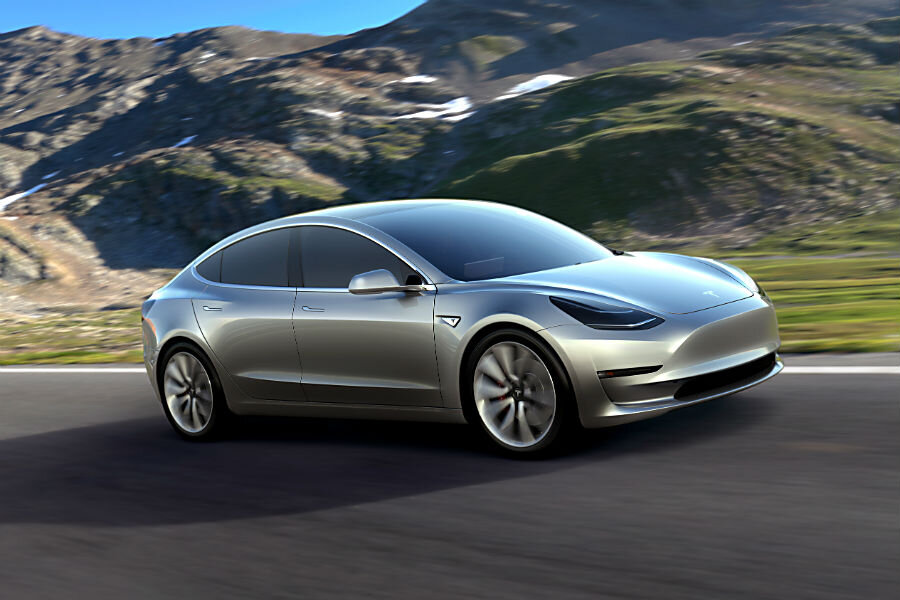Can Elon Musk meet demand for the Tesla Model 3?
Loading...
Following its unveiling Thursday night, Tesla Motors, Inc.’s new Model 3 electric sedan now has tens of thousands of consumers paying $1,000 each to reserve their own car. But deliveries won't start until in late 2017.
The Model 3 is Tesla’s attempt at providing a lower-cost alternative to the automaker's premium electric vehicles. The base price is $35,000 before incentives, well below what Tesla's Model S sedan and Model X sports utility vehicle sell for.
Following its unveiling this week, hundreds of people lined up outside of Tesla stores around the world to reserve their own Model 3s. Tesla founder, chairman, and CEO Elon Musk said that demand for the electric cars is far outpacing his projections, with 276,000 reservations placed through Saturday, according to Mr. Musk’s Twitter account.
Barclays analyst Brian Johnson had previously estimated the Model 3 would receive 250,000 to 300,000 orders by June, Reuters reported, suggesting production and delivery of the vehicles on time could prove troublesome for Tesla.
The automaker has only delivered slightly more than 110,000 vehicles in its history, including its Roadster, Model S, and Model X. And delivery dates on those models kept slipping. So despite the scheduled 2017 Model 3 release, customers may not see their reservations fulfilled for years, depending on how quickly Tesla can increase production capacity.
As Bloomberg noted, there are tax credits on the line:
People questioned how quickly Tesla would be able to fill all those orders, and whether U.S. customers would be able to take advantage of the $7,500 federal tax credit for electric car buyers before it expired. The credit will probably begin to phase out for Tesla around October 2018. The company's plan "should enable large numbers" of new customers—not just current owners of Teslas—to receive the credit, Musk wrote. He also said production should ramp up in time for East Coast customers to qualify for the credit, even though deliveries will start near Tesla's factories in California so the company can quickly respond to any problems with the first cars off the line. if production capacity
While Tesla has previously produced only luxury cars and still has a relatively limited vehicle charging and sales infrastructure, the wide release of the Model 3 could bring the company up to compete with more established automakers. Tesla has existed only since 2003, and it posted its first year of profit in 2013, but it has already made gains in the electric car market, with its Model S second in cumulative sales only to Nissan’s Leaf.
Now, its Model 3 could be poised to reach an even larger audience than ever before. Its lower price and reported 215 miles of range per charge could open Tesla up to consumers who had never considered going electric before. The Nissan Leaf, Hyundai Ioniq, and BMW i3, for comparison, have ranges of around 80 to 110 miles at around the same cost. As of December, total sales for the Leaf to date reached 200,000.
“You're not seeing people wait in long lines to purchase a Chevy Bolt, considering it comes out much sooner and the range is about the same,” Edmunds.com analyst Jessica Caldwell told The Associated Press. The Bolt can go around 200 miles per charge, according to Chevrolet, and will retail for about the same price as a Model 3. She said that, despite the deposit and year-plus wait for Tesla’s vehicle, the Tesla's place in popular and consumer culture as well as its cars’ environmental impact have people interested in the motor company’s moves.
“You felt like the lifestyle was attainable in his talk,” Caldwell said of Musk’s Thursday night Model 3 announcement.
Tesla plans to expand its production in hopes of increasing its yearly capacity to 500,000 by the end of the decade. But can Tesla satisfy the demand for Tesla 3? When will customers who placed their orders now, actually get their cars?








